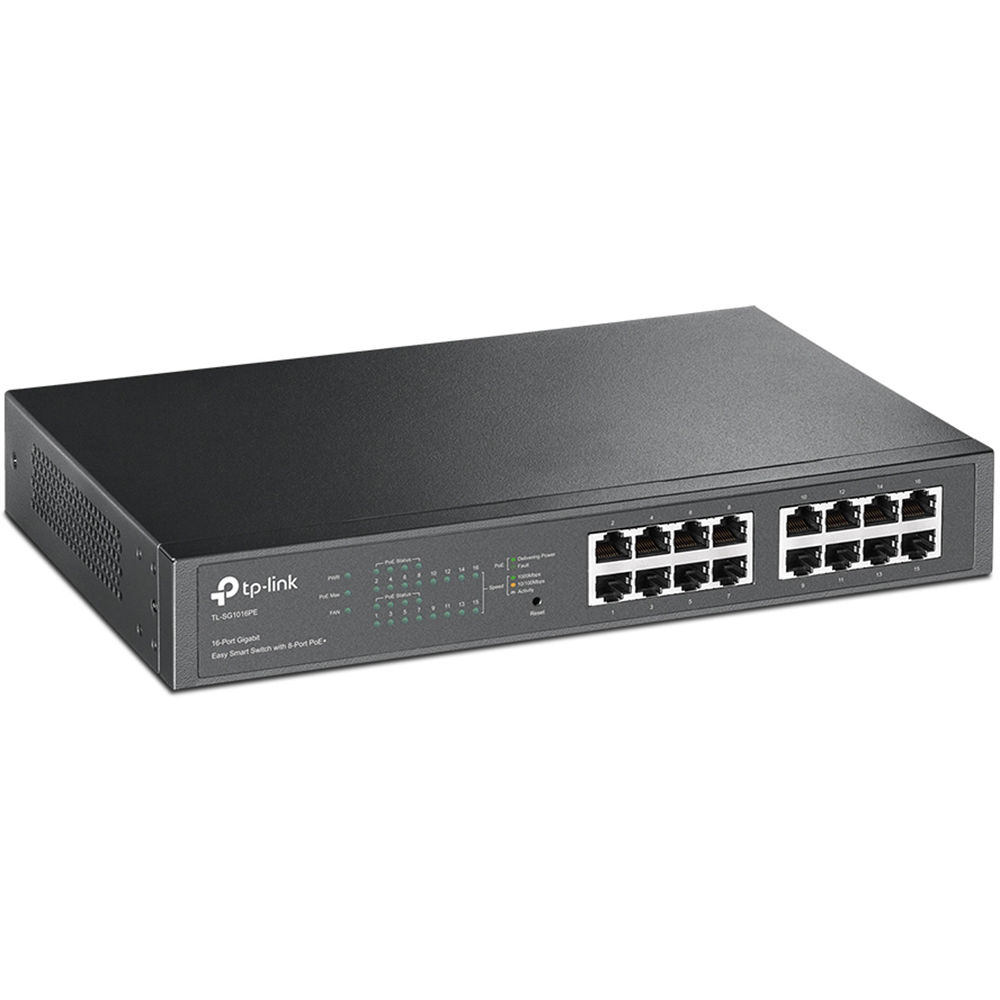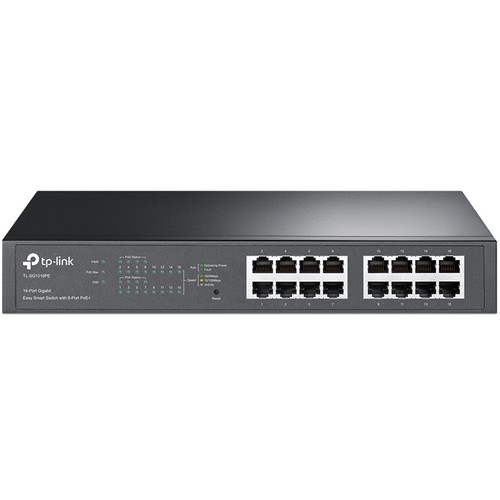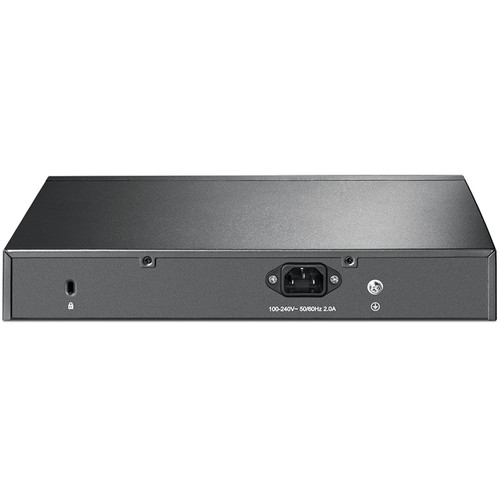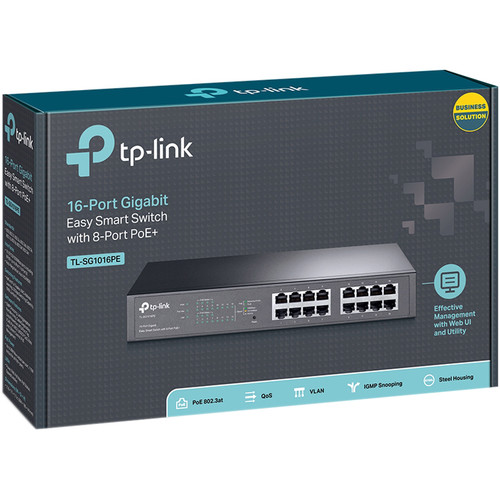TP-Link TL-SG1016PE 16-Port Gigabit PoE+ Managed Switch
$119.99
In stock
Description
With support for the 802.3af/at PoE networking standard, the TL-SG1016PE 16-Port Gigabit PoE+ Managed Switch from TP-Link is designed to power a variety of PoE-compatible devices such as IP cameras, IP phones, access points, and more.
Simply plug in your PoE-compliant device into any of the eight Gigabit Ethernet PoE-compliant ports and you can begin powering that device directly through the network connection. Along with the PoE ports, you will find eight additional Gigabit Ethernet ports to connect a total of sixteen Ethernet-enabled devices to the switch. The TL-SG1016PE switch features a 32 Gb/s switching capacity, a 23.8 Mb/s forwarding rate, an 8K MAC address table, and a 9KB jumbo frame to ensure the switch operates smoothly even under demanding network conditions.
Additional information
| Weight | 5.05 lbs |
|---|---|
| Dimensions | 15.9 × 9.9 × 3.25 in |
| Standards and Protocols | IEEE 802.3, IEEE 802.3u, IEEE 802.3ab, IEEE 802.3x, IEEE 802.1q, IEEE 802.1p |
| Jumbo Frame | 9 KB |
| System Requirements | Microsoft Windows for running Utility |
| Certifications | FCC, CE, RoHS |
| Transmission Method | Store-And-Forward |
| Management | Web-based GUI<br> |
| VLAN | Supports up to 128 VLANs simultaneously (out of 4K VLAN IDs)<br> |
| L2 Services | IGMP Snooping V1/V2/V3<br> |
| Quality of Service (QoS) | Support Port-Based/802.1p/DSCP priority<br> |
| Packet Memory Buffer | 4.1 Mbit |
| Interface | 16 x 10/100/1000 Mb/s RJ-45 ports<br> |
| MAC Address Table | 8 K |
| Packet Forwarding Rate | 23.8 Mb/s |
| Switching Capacity | 32 Gb/s |
| PoE Ports | Standard: 802.3at compliant<br> |
| Power Consumption | Maximum: 124.4 W (220 V/50 Hz) |
| Power Supply | 100-240 VAC, 50/60 Hz |
| Fan Quantity | 1 |
| Network Media | 10BASE-T: UTP category 3, 4, 5 cable (maximum 328' / 100 m)<br> |
| Temperature & Humidity | Operating Temperature<br> |
Reviews (4)
4 reviews for TP-Link TL-SG1016PE 16-Port Gigabit PoE+ Managed Switch
Only logged in customers who have purchased this product may leave a review.
Related products
Wired Networking
Wired Networking
Wired Networking
Synology E25G21-F2 Dual 25G Ethernet SFP+ Port PCIe 3.0 Adapter
Wired Networking
Wired Networking
Netgear GS516PP 16-Port Gigabit PoE+ Compliant Unmanaged Switch
Wired Networking





Skyla Rempel (verified owner) –
Bought this to serve as the primary switch in my home network, as I wanted to start isolating IoT devices from my main network, eliminate a standalone PoE injector, consolidate smaller switches, etc. The first thing I noticed when plugging it in is that the fan is quite loud and runs continuously, making this switch unsuitable for any occupied area. Its far louder than any PC I own or use, and louder even than our primary server at work (which has 7 mechanical HDDs). Theres a fan LED on the front, which teases that perhaps the fan can be configured to trigger on load or temperature, but sadly thats not the case. The second issue I encountered was that the management interface can only run on VLAN1, which prevents this switch from interoperating with Ubiquiti equipment that prohibits the use of VLAN1. (Its a silly limitation on Ubiquitis part, but Id rather give up TP-Link than Ubiquiti.) TP-Link will sell you a more expensive switch that allows changing the management VLAN, but thatd be silly when certain competitors switches at this same price point dont have the same limitation. At least theres a firmware update that allows ports to be removed from VLAN1 or set as tagged. That let me work around the issue, although I had to jump through some hoops with my network design in order to do so. Cosmetically, the web interface looks like it was created 20+ years ago. Not a deal-breaker, but detracts a bit from usability. More annoying is that TP-Links firmware updates (at least for this class of device) all appear to be specific to a particular hardware revision. I know thats sometimes unavoidable, for example if new features require more memory than is present in older hardware, but in this case it seems to be standard operating procedure. I really wanted to make this switch work since I got it on sale, but in the end, based on the noise and general clunkiness of setup, Im returning it in favor of the equivalent Netgear.
Alicia Crooks (verified owner) –
This switch is just the right size and does what we need, works great. Plug and Play just like it says and the price was right. B&H did a great job from the website to the price of the switch, to the very fast delivery. Will use them again for sure.
Dashawn Blanda (verified owner) –
Compact. Built-in AC power supply means no power brick to come loose. Fan noise too loud for most office environments, and no fan control in software. Better to use TP-Link POE switches with power bricks where silence is needed.
Johnathan Zieme (verified owner) –
A small fan keeps the switch cool enough in warm environments. Since only eight of the 16 ports have POE capability, this switch is best suited to smaller offices with few POE devices, or for distributed POE implementations in larger work spaces. We thought the fan was too noisy for quiet offices or homes, so we were disappointed to find that there is no intelligent thermal control for the fan. A larger, quieter fan or bank of fans running slower would have been far better, along with the option to switch them off in cool or cold environments. Sealed POE switches with secure power cords and outstanding external heat dissipation is what we still seek because this switch would not last long in industrial settings with dust and high humidity. POE switches with POE+ source power would also tend to produce less heat to dissipate in tough environments. A built-in AC power supply is a desirable feature compared to desktop POE switches that depend on external power bricks and DC power cords that disconnect too easily, but POE+ type 48vDC source power would be best.